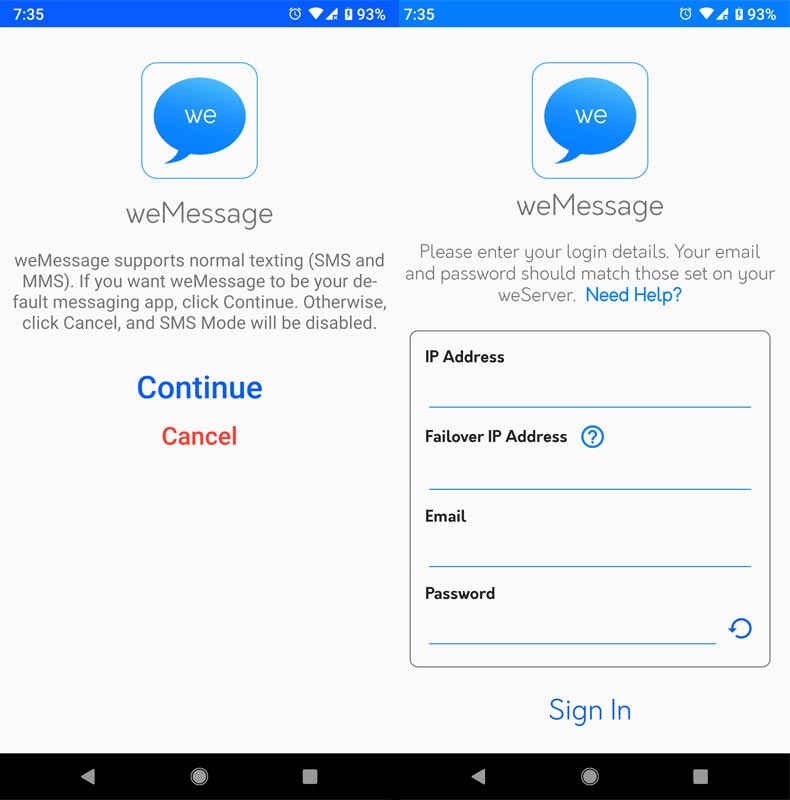

- #CAN WE USE IMESSAGE ON ANDROID FOR FREE#
- #CAN WE USE IMESSAGE ON ANDROID INSTALL#
- #CAN WE USE IMESSAGE ON ANDROID ANDROID#
- #CAN WE USE IMESSAGE ON ANDROID PRO#
- #CAN WE USE IMESSAGE ON ANDROID SOFTWARE#
Obviously, you can change these settings if you aren’t actively using AirMessage. From there, select “Energy Saver” and set the “Computer Sleep” to never. You can do this by clicking the Apple icon at the top of the screen and clicking System Preferences. You can let the display sleep but you’ll need to set the computer itself to stay away. Since your macOS machine is acting as a server, you’ll want it set up to never sleep. Once you’re connected, you can move on to the next steps. You will want to use the same Google account that you use on your Chromebook to connect AirMessage. You will be prompted to connect an account. Once you’ve downloaded AirMessage server to your macOS device, double-click the file to initiate the setup process. ( Note: According to the website, AirMessage is compatible with the new Apple silicon.) You can find the AirMessage macOS server application here.
#CAN WE USE IMESSAGE ON ANDROID ANDROID#
The server runs in the background and acts as a passthrough to and from your macOS device to the AirMessage app on your Android device.
#CAN WE USE IMESSAGE ON ANDROID INSTALL#
In order to do this, you will need to install the AirMessage server application on your macOS machine. Instead, we’ll use the AirMessage app to act as our portal to the macOS host machine. This can be done with Chrome Remote Desktop but that’s a bit of a heavier lift and somewhat overkill for this task. Since we can’t install iMessage on a Chromebook, we need a “host” device to remote to in order to access iMessage. If you’re wondering why you need a macOS device, the answer is simple.
#CAN WE USE IMESSAGE ON ANDROID FOR FREE#
If you just want to try this out and don’t have an Apple ID, you can get one here for free and use it with iMessage on a desktop without a phone number attached. If you’re reading this tutorial to use iMessage with your iPhone, you’re good. Last but not least, you’ll need an Apple ID to use with iMessage. You’ll also need an Android device that’s running Android 6.0 or newer but since we’re doing this on a Chromebook, that’s already covered.
#CAN WE USE IMESSAGE ON ANDROID PRO#
For my testing, I used a 2010 Macbook Pro that I updated to macOS El Capitan (macOS 10.11). They are few but they are 100% necessary.įirst off, you will need a macOS device that is running macOS 10.10 Yosemite or newer. Before we get started, there are a couple of prerequisites to make this work. AirMessage isn’t the only app out there that does this little trick but it’s the best one I’ve tested and the installation process is a breeze. There are a couple of different methods to achieve this but today, we’ll be looking at a third-party application called AirMessage. While you can’t install iMessage on a Chromebook, you can use the cloud-centric operating system to remotely access the messaging application. Thankfully, where there’s a will, there’s a way. For that reason, it is not possible to install iMessage on an Android or any other non-Apple OS.
#CAN WE USE IMESSAGE ON ANDROID SOFTWARE#
As you are likely aware, Apple isn’t savvy to the idea of their in-house messaging app running on anything other than their own software platforms. However, if you’re wanting to access your iMessage on Chrome OS, the answer isn’t that simple. If you’re using third-party chat apps, you can always install the web version on your Chromebook and get your notifications via Chrome or a PWA. This is all great news if you’re an Android user but what about those that prefer an iPhone? Unfortunately, these integrations will likely never find themselves paired with an iOS device but that doesn’t mean that you’re left out to dry. Thanks to the ongoing work around the project known as “ Eche,” we will eventually have the ability to mirror applications directly to our Chromebooks in a free-standing window on the desktop. Soon, Android devices and Chromebooks will further blur the line between desktop and mobile.

You can silence your phone right from the shelf of your Chromebook and even use the locate phone feature to ring your device if you’ve misplaced it. Phone Hub allows you to access your device’s notifications, reply to messages, view recent Chrome tabs, and more. With the evolution of the in-built Chrome OS Phone Hub, the symbiotic relationship between Chromebook and Android phones has become near-seamless and it just keeps getting better. It goes without saying that Google’s Chrome operating system lends itself much more to those of us who use Android smartphones.


 0 kommentar(er)
0 kommentar(er)
